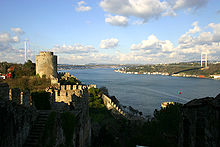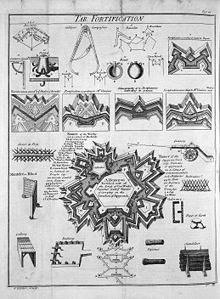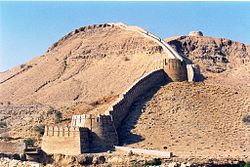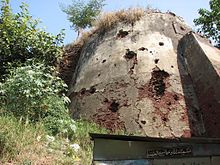- Fortification
-
"Fort" and "Fortress" redirect here. For other uses, see Fort (disambiguation) and Fortress (disambiguation).
Fortifications are military constructions and buildings designed for defence in warfare and military bases. Humans have constructed defensive works for many thousands of years, in a variety of increasingly complex designs. The term is derived from the Latin fortis ("strong") and facere ("to make").
Contents
Nomenclature
Many military installations are known as forts, although they are not always fortified. Larger forts may class as fortresses; smaller ones formerly often bore the name of fortalices. The word fortification can also refer to the practice of improving an area's defence with defensive works. City walls are fortifications but not necessarily called fortresses.
The art of setting out a military camp or constructing a fortification traditionally classifies as castramentation, since the time of the Roman legions. The art/science of laying siege to a fortification and of destroying it has the popular name of siegecraft or 'siege warfare' and the formal name of poliorcetics. In some texts this latter term also applies to the art of building a fortification.
Fortification is usually divided into two branches, namely permanent fortification and field fortification. Permanent fortifications are erected at leisure, with all the resources that a state can supply of constructive and mechanical skill, and are built of enduring materials. Field fortifications are extemporized by troops in the field, perhaps assisted by such local labour and tools as may be procurable and with materials that do not require much preparation, such as earth, brushwood and light timber, or sandbags (see sangar).
There is also an intermediate branch known as semi-permanent fortification. This is employed when in the course of a campaign it becomes desirable to protect some locality with the best imitation of permanent defences that can be made in a short time, ample resources and skilled civilian labour being available.
Castles are fortifications which are regarded as being distinct from the generic fort or fortress in that it describes a residence of a monarch or noble and commands a specific defensive territory.
History
Ancient
From very early history to modern times, walls have been a necessity for many cities. Uruk in ancient Sumer (Mesopotamia) is one of the world's oldest known walled cities. The Ancient Egyptians also built fortresses on the frontiers of the Nile Valley to protect against invaders from its neighbouring territories. Many of the fortifications of the ancient world were built with mud brick, leaving many no more than mounds of dirt for today's archaeologists.
The Assyrians deployed large labour forces to build new palaces, temples and defensive walls.[2]
Some settlements in the Indus Valley Civilization were also fortified. By about 3500 B.C., hundreds of small farming villages dotted the Indus floodplain. Many of these settlements had fortifications and planned streets. The stone and mud brick houses of Kot Diji were clustered behind massive stone flood dykes and defensive walls, for neighbouring communities bickered constantly about the control of prime agricultural land.[3] Mundigak (c. 2500 B.C.) in present day south-east Afghanistan has defensive walls and square bastions of sun dried bricks.[4]
Babylon was one of the most famous cities of the ancient world, especially as a result of the building program of Nebuchadnezzar, who expanded the walls and built the Ishtar Gate.
Exceptions were few—notably, ancient Sparta and ancient Rome did not have walls for a long time, choosing to rely on their militaries for defence instead. Initially, these fortifications were simple constructions of wood and earth, which were later replaced by mixed constructions of stones piled on top of each other without mortar.
In Central Europe, the Celts built large fortified settlements known as oppida, whose walls seem partially influenced by those built in the Mediterranean. The fortifications were continuously being expanded and improved.
In ancient Greece, large stone walls had been built in Mycenaean Greece, such as the ancient site of Mycenae (famous for the huge stone blocks of its 'cyclopean' walls). In classical era Greece, the city of Athens built a long set of parallel stone walls called the Long Walls that reached their guarded seaport at Piraeus.
Large tempered earth (i.e. rammed earth) walls were built in ancient China since the Shang Dynasty (c. 1600-1050 BC), as the capital at ancient Ao had enormous walls built in this fashion (see siege for more info). Although stone walls were built in China during the Warring States (481-221 BC), mass conversion to stone architecture did not begin in earnest until the Tang Dynasty (618-907 AD).
In terms of China's longest and most impressive fortification, the Great Wall had been built since the Qin Dynasty (221-207 BC), although its present form was mostly an engineering feat and remodelling of the Ming Dynasty (1368-1644 AD). The large walls of Pingyao serve as one example. Likewise, the famous walls of the Forbidden City in Beijing were established in the early 15th century by the Yongle Emperor.
The Romans fortified their cities with massive, mortar-bound stone walls. The most famous of these are the largely extant Aurelian Walls of Rome and the Theodosian Walls of Constantinople, together with partial remains elsewhere. These are mostly city gates, like the Porta Nigra in Trier or Newport Arch in Lincoln.
Hadrian's Wall was built by the Roman Empire across the width of what is now northern England following a visit by Roman Emperor Hadrian (AD 76–138) in AD 122.
Medieval
Roman forts and hill forts were the main antecedents of castles in Europe, which emerged in the 9th century in the Carolingian Empire.
The Early Middle Ages saw the creation of some towns built around castles. These cities were only rarely protected by simple stone walls and more usually by a combination of both walls and ditches. From the 12th century AD hundreds of settlements of all sizes were founded all across Europe, which very often obtained the right of fortification soon afterwards.
 The fortified city of Valença, Portugal as seen from across the Minho River (Portugal's northern border with Spain)
The fortified city of Valença, Portugal as seen from across the Minho River (Portugal's northern border with Spain)
The founding of urban centres was an important means of territorial expansion and many cities, especially in eastern Europe, were founded precisely for this purpose during the period of Eastern Colonisation. These cities are easy to recognise due to their regular layout and large market spaces. The fortifications of these settlements were continuously improved to reflect the current level of military development.
During the Renaissance era, the Venetians raised great walls around cities threatened by the Ottoman empire. The finest examples are, among others, in Nicosia (Cyprus) and Chania (Crete), and they still stand, to this day.
Early Modern
Medieval-style fortifications were largely made obsolete by the arrival of cannons on the 14th century battlefield. Fortifications in the age of blackpowder evolved into much lower structures with greater use of ditches and earth ramparts that would absorb and disperse the energy of cannon fire. Walls exposed to direct cannon fire were very vulnerable, so were sunk into ditches fronted by earth slopes.
This placed a heavy emphasis on the geometry of the fortification to allow defensive cannonry interlocking fields of fire to cover all approaches to the lower and thus more vulnerable walls.
The evolution of this new style of fortification can be seen in transitional forts such as Sarzanello[5] in North West Italy which was built between 1492 and 1502. Sarzanello consists of both crenallated walls with towers typical of the medieval period but also has a ravelin like angular gun platform screening one of the curtain walls which is protected from flanking fire from the towers of the main part of the fort.
Fortifications also extended in depth, with protected batteries for defensive cannonry, to allow them to engage attacking cannon to keep them at a distance and prevent them bearing directly on the vulnerable walls.
The result was star shaped fortifications with tier upon tier of hornworks and bastions, of which Bourtange illustrated to the right is an excellent example. There are also extensive fortifications from this era in the Nordic states and in Britain, the fortifications of Berwick-upon-Tweed and the harbour archipelago of Suomenlinna at Helsinki being fine examples.
19th Century
The arrival of explosive shells in the 19th century led to yet another stage in the evolution of fortification. Star forts of the cannon era did not fare well against the effects of high explosive and the intricate arrangements of bastions, flanking batteries and the carefully constructed lines of fire for the defending cannon could be rapidly disrupted by explosive shells.
Worse, the large open ditches surrounding forts of this type were an integral part of the defensive scheme, as was the covered way at the edge of the counter scarp. The ditch was extremely vulnerable to bombardment with explosive shells.
In response, military engineers evolved the polygonal style of fortification. The ditch became deep and vertically sided, cut directly into the native rock or soil, laid out as a series of straight lines creating the central fortified area that gives this style of fortification its name.
Wide enough to be an impassable barrier for attacking troops, but narrow enough to be a difficult target for enemy shellfire, the ditch was swept by fire from defensive blockhouses set in the ditch as well as firing positions cut into the outer face of the ditch itself.
The profile of the fort became very low indeed, surrounded outside the ditch by a gently sloping open area so as to eliminate possible cover for enemy forces, while the fort itself provided a minimal target for enemy fire. The entrypoint became a sunken gatehouse in the inner face of the ditch, reached by a curving ramp that gave access to the gate via a rolling bridge that could be withdrawn into the gatehouse.
Traditional fortification however continued to be applied by European armies engaged in warfare in colonies established in Africa against lightly armed attackers from amongst the indigenous population. A relatively small number of defenders in a fort impervious to iron-age weaponry could hold out against high odds, the only constraint being the supply of ammunition.
Much of the fort moved underground, with deep passages and tunnels to connect the blockhouses and firing points in the ditch to the fort proper, with magazines and machine rooms deep under the surface.
The guns however, were often mounted in open emplacements and protected only by a parapet - both in order to keep a lower profile and also because experience with guns in closed casemates had seen them put out of action by rubble as their own casemates were collapsed around them.
20th and 21st Centuries
Steel-and-concrete fortifications were common during the 19th and early 20th centuries. However the advances in modern warfare since World War I have made large-scale fortifications obsolete in most situations. Only underground bunkers are still able to provide some protection in modern wars. Many historical fortifications were demolished during the modern age, but a considerable number survive as popular tourist destinations and prominent local landmarks today.
The downfall of permanent fortifications had two causes:
- The ever escalating power, speed, and reach of artillery and air power meant that almost any target that could be located could be destroyed, if sufficient force were massed against it. As such, the more resources a defender devoted to reinforcing a fortification, the more combat power that fortification justified being devoted to destroying it, if the fortification's destruction was demanded by an attacker's strategy. By 1950, nuclear weapons were capable of destroying entire cities, and produced dangerous radiation. This led to the creation of civilian nuclear air raid shelters. In the late 20th century, bunker busters were being used against bunkers.
- The second weakness of permanent fortification was its very permanency. Because of this it was often easier to go around a fortification and, with the rise of mobile warfare in the beginning of World War II, this became a viable offensive choice. When a defensive line was too extensive to be entirely bypassed, massive offensive might could be massed against one part of the line allowing a breakthrough, after which the rest of the line could be bypassed. Such was the fate of the many defensive lines built before and during World War II, such as the Siegfried Line, the Stalin Line and the Atlantic Wall. Note that this was not the case of the Maginot Line, designed to force the Germans to pass through Belgium and that has fully achieved its political and strategic role[6].
Instead field fortification rose to dominate defensive action. Unlike the trench warfare which dominated World War I, these defences were more temporary in nature. This was an advantage because since it was less extensive it formed a less obvious target for enemy force to be directed against.
If sufficient power were massed against one point to penetrate it, the forces based there could be withdrawn and the line could be re-established relatively quickly. Instead of a supposedly impenetrable defensive line, such fortifications emphasized defence in depth, so that as defenders were forced to pull back or were overrun, the lines of defenders behind them could take over the defence.
Because the mobile offensives practised by both sides usually focused on avoiding the strongest points of a defensive line, these defences were usually relatively thin and spread along the length of a line. The defence was usually not equally strong throughout however.
The strength of the defensive line in an area varied according to how rapidly an attacking force could progress in the terrain that was being defended—both the terrain the defensive line was built on and the ground behind it that an attacker might hope to break out into. This was both for reasons of the strategic value of the ground, and its defensive value.
This was possible because while offensive tactics were focused on mobility, so were defensive tactics. The dug in defences consisted primarily of infantry and antitank guns. Defending tanks and tank destroyers would be concentrated in mobile "Fire Brigades" behind the defensive line. If a major offensive was launched against a point in the line, mobile reinforcements would be sent to reinforce that part of the line that was in danger of failing.
Thus the defensive line could be relatively thin because the bulk of the fighting power of the defenders was not concentrated in the line itself but rather in the mobile reserves. A notable exception to this rule was seen in the defensive lines at the Battle of Kursk during World War II, where German forces deliberately attacked into the strongest part of the Soviet defences seeking to crush them utterly.
The terrain that was being defended was of primary importance because open terrain that tanks could move over quickly made possible rapid advances into the defenders' rear areas that were very dangerous to the defenders. Thus such terrain had to be defended at all cost.
In addition, since in theory the defensive line only had to hold out long enough for mobile reserves to reinforce it, terrain that did not permit rapid advance could be held more weakly because the enemy's advance into it would be slower, giving the defenders more time to reinforce that point in the line. For example, the battle of the Hurtgen Forest in Germany during the closing stages of World War II is an excellent example of how impassable terrain could be used to the defenders' advantage.
After World War II, ICBMs capable of reaching much of the way around the world (and rockets capable of reaching the Moon and other nearby celestial bodies) were developed, and so speed became an essential characteristic of the strongest militaries and defenses. Missile silos were developed, so missiles could be fired from the middle of a country and hit cities and targets in another country, and airplanes (and air carriers) became major defenses and offensive weapons (leading to an expansion of the use of airports and airstrips as fortifications). Mobile defenses could be had underwater, too, in the form of nuclear submarines capable of firing missiles. Some bunkers in the mid to late 20th century came to be buried deep inside mountains and prominent rocks, such as Gibraltar and Cheyenne Mountain. On the ground itself, minefields have been used as hidden defences in modern warfare, often remaining long after the wars that have produced them have ended.
Demilitarized zones along borders are arguably another type of fortification, although a passive kind, providing a buffer between potentially hostile militaries.
Forts
.
Forts in modern usage often refer to space set aside by governments for a permanent military facility; these often do not have any actual fortifications, and can have specializations (military barracks, administration, medical facilities, or intelligence). In the United States usage, forts specifically refer to Army fortifications; Marine Corps fortifications are referred to as camps.[citation needed]
However there are some modern fortifications that are referred to as forts. These are typically small semi permanent fortifications. In urban combat they are built by upgrading existing structures such as houses or public buildings. In field warfare they are often log, sandbag or gabion type construction.
Such forts are typically only used in low level conflict, e.g., counterinsurgency conflicts or very low level conventional conflicts, e.g., the Indonesia–Malaysia confrontation saw the use of log forts for use by forward platoons and companies. The reason for this is that static above ground forts can not survive modern direct or indirect fire weapons larger than mortars, RPGs and small arms.
North America
 Fort Snelling on the confluence of the Mississippi and Minnesota Rivers, 1844. Image painted by John Caspar Wild (1804-1846).
Fort Snelling on the confluence of the Mississippi and Minnesota Rivers, 1844. Image painted by John Caspar Wild (1804-1846).
In British North America, and subsequently in the frontiers of the United States, prior to the 20th century the term fort was increasingly used for any military base of operations regardless of how fortified it was. Military forts in the American Old West during the Indian Wars were often lightly fortified enclosures with log or adobe walls. In many areas the term fort was used to refer to any European or U.S. outpost, military, para-military, or civilian, that was located in an undeveloped region. Many of these outposts were simply trading posts or a combination of a trading post and an Army post.
Some famous U.S. military forts included Fort Laramie and Fort Bridger on the Emigrant Trail and Bent's Fort on the Arkansas River.
Prisons and others
Fortifications designed to keep the inhabitants of a facility in rather than out can also be found, in prisons, concentration camps, and other such facilities, with supermaxes having some of the strongest of those. Those are covered in other articles, as most prisons and concentration camps are not primarily military forts (although forts, camps, and garrison towns have been used as prisons and/or concentration camps; see Theresienstadt, Guantanamo Bay, and the Tower of London for examples).
See also
 Captain John Smith's 1624 map of Bermuda, showing important sites, including the Castle Islands Fortifications.
Captain John Smith's 1624 map of Bermuda, showing important sites, including the Castle Islands Fortifications.
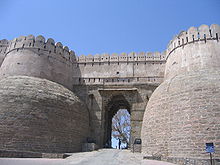 The Kumbhalgarh Fort in Rajasthan, India is one of the longest forts in Asia. The Fort was built by Rana Kumbha in the 15th century and more than 350 Hindu and Jain temples are located within it. For more than 3 centuries, the Fort remained impregnable until it was taken by the combined forces of Akbar, Malwa and the Gujarat Sultanate.
The Kumbhalgarh Fort in Rajasthan, India is one of the longest forts in Asia. The Fort was built by Rana Kumbha in the 15th century and more than 350 Hindu and Jain temples are located within it. For more than 3 centuries, the Fort remained impregnable until it was taken by the combined forces of Akbar, Malwa and the Gujarat Sultanate. Klis Fortress in Croatia, built into the south face of a rocky mass, barely discernable as a man-made structure. From its origin as a small stronghold, becoming a royal castle that was the seat of many Croatian kings, to its final development as a large fortress during the Ottoman wars in Europe, Klis Fortress has guarded the frontier, being lost and re-conquered several times throughout its more than two thousand year-long history.
Klis Fortress in Croatia, built into the south face of a rocky mass, barely discernable as a man-made structure. From its origin as a small stronghold, becoming a royal castle that was the seat of many Croatian kings, to its final development as a large fortress during the Ottoman wars in Europe, Klis Fortress has guarded the frontier, being lost and re-conquered several times throughout its more than two thousand year-long history.
 Rödberget fort, a part of the modern Boden Fortress in Sweden, seen from the north. The moat and the armored turrets are clearly visible, as well as the magnificent view one has from the fort.
Rödberget fort, a part of the modern Boden Fortress in Sweden, seen from the north. The moat and the armored turrets are clearly visible, as well as the magnificent view one has from the fort. Fortifications of Edinburgh Castle used the natural volcanic landscape to best advantage. Image painted by Alexander Nasmyth (~1780).
Fortifications of Edinburgh Castle used the natural volcanic landscape to best advantage. Image painted by Alexander Nasmyth (~1780).
Fort components
- Abatis
- Banquette
- Barbed wire, Razor wire, Wire entanglement, and Wire obstacle
- Bartizan
- Bastion
- Berm
- Caponier
- Casemate
- Curtain
- Czech hedgehog
- Defensive fighting position (aka a "foxhole")
- Ditch
- Embrasure
- Glacis
- Gun turret
- Keep
- Palisade
- Parapet
- Pillbox
- Postern
- Ravelin
- Revetment
- Sandbag
- Scarp and Counterscarp
- Turret
Types of forts and fortification
- Bastion fortress
- Blanket fort
- Blockhouse
- Bunker
- Castle
- City wall
- Chinese city wall
- Compound
- Diaolou
- Fire support base
- Flak tower
- Grad, a Slavic wooden fortified settlement
- Hill fort
- Land battery
- Martello tower
- Medieval fortification
- Missile silo
- Pā a 19th-century Māori fortification
- Peel tower
- Polygonal fort
- Promontory fort
- Redoubt
- Stockade
- Star fort
Fortification and siege warfare
Famous experts
- Henri Alexis Brialmont
- César Cui
- Diades of Pella
- Mozi
- James of St. George
- Bernard de Gomme
- Fritz Todt
- Menno van Coehoorn
- Vauban
External links
- Fortress Study Group
- Militaryarchitecture.com
- Study of Fortifications in Slovenia
- Fortifications in Slovenia
References
- ^ Crac des Chevaliers and Qal'at Salah El-Din, UNESCO, http://whc.unesco.org/en/list/1229, retrieved 2009-10-20
- ^ Banister Fletcher's A History of Architecture By Banister Fletcher, Sir, Dan Cruickshank, Dan Cruickhank, Sir Banister Fletcher. Published 1996 Architectural Press. Architecture. 1696 pages. ISBN 0750622679. pg no 20
- ^ The Encyclopedia of World History: ancient, medieval, and modern, chronologically arranged By Peter N. Stearns, William Leonard Langer. Compiled by William L. Langer. Published 2001 Houghton Mifflin Books. History / General History. ISBN 0395652375. pg 17
- ^ Banister Fletcher's A History of Architecture By Banister Fletcher, Sir, Dan Cruickshank, Dan Cruickhank, Sir Banister Fletcher. Published 1996 Architectural Press. Architecture. 1696 pages. ISBN 0750622679. pg no 100
- ^ Harris, J., "Sarzana and Sarzanello - Transitional Design and Renaissance Designers", Fort (Fortress Study Group), No. 37, 2009, pp. 50-78
- ^ [Halter, Marc; History of the Maginot Line, Moselle River, 2011. ISBN 978-2952309257]
- ^ Albania's Chemical Cache Raises Fears About Others—Washington Post, Monday 10 January 2005, p. A01.
 This article incorporates text from a publication now in the public domain: Chisholm, Hugh, ed (1911). Encyclopædia Britannica (11th ed.). Cambridge University Press.
This article incorporates text from a publication now in the public domain: Chisholm, Hugh, ed (1911). Encyclopædia Britannica (11th ed.). Cambridge University Press.Stonemasonry Types Materials List of stone • Artificial stone • Brick • Cast stone • Decorative stones • Dimension stone • Fieldstone • Flagstone • Gabions • Granite • Marble • Mortar • Sandstone • SlateTools Angle grinder • Bush hammer • Ceramic tile cutter • Chisel • Diamond blade • Lewis (lifting appliance) • Non-explosive demolition agents • Plug and feather • Stonemason's hammer • StraightedgeTechniques Products Organizations Categories:- Fortification
- Castles
- Military strategy
- Military installations
- Forts
Wikimedia Foundation. 2010.









